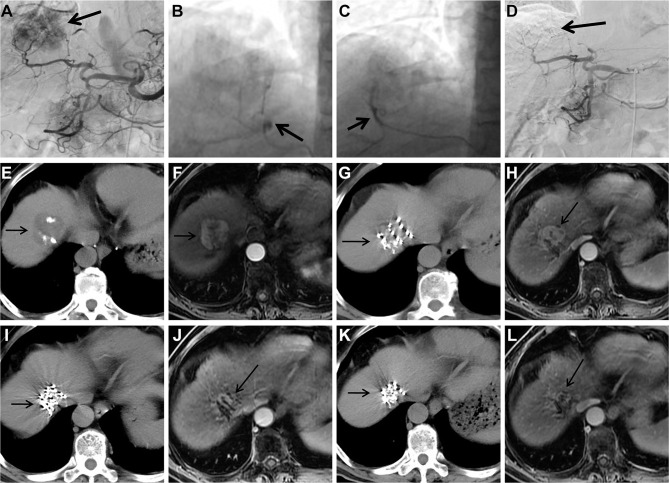Figure 2.
Images from case 12. Male, 72 years of age, HCC. The lesion is located at S8 with a diameter of 4.0 cm.
Notes: (A) Selective angiography of the celiac trunk during the fourth cTACE procedure shows tumor staining (arrow); (Band C) selection of feeding arteries and embolization (arrow); (D) selective angiography of the common hepatic artery shows tumor staining disappears after embolization (arrow); (E) follow-up CT scan 2 months after the fourth cTACE shows asmall amount of lipiodol accumulation within the HCC lesion (arrow); (F) follow-up contrast-enhanced MRI 2 months after the fourth cTACE shows persistent contrast enhancement of the HCC lesion (arrow); (G) 125I brachytherapy for TACE-refractory HCC is performed under the guidance of CT (arrow); (H) follow-up contrast-enhanced MRI 1 month after 125I brachytherapy shows HCC lesion is stable (arrow); (I) follow-up CT 4 months after 125Ibrachytherapy shows particles aggregation (arrow); (J) follow-up contrast-enhanced MRI 4 months after 125Ibrachytherapy shows partial response of the HCC lesion (arrow); (K) follow-up CT 6 months after 125Ibrachytherapy shows marked particles aggregation (arrow); (L) follow-up contrast-enhanced MRI 6 months after 125Ibrachytherapy shows partial response of the TACE-refractory HCC lesion (arrow).
Abbreviations: HCC, hepatocellular carcinoma; cTACE, conventional transarterial chemoembolization; CT, computed tomography; MRI, magnetic resonance imaging; TACE, transarterial chemoembolization.

